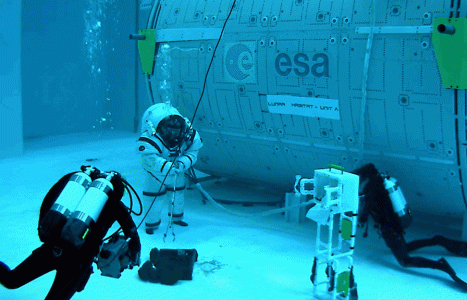Concept Development of EVA Operationsin EAC Neutral Buoyancy Facility for Extra-terrestrial Surface Explorations. (Moondive)

The International Space Station (ISS) is slowly approaching the end of its mission. The European Space Agency (ESA) and its international partners are considering new mission targets for the future of human space exploration in the post-ISS era. Highest ranked on the list of potential targets are a return to the Moon, Near-Earth Objects or asteroids, the moons of Mars (Phobos, Deimos) and, as the ultimate target, the surface of Mars. The Neutral Buoyancy Facility (NBF) at the European Astronaut Centre (EAC), Cologne, serves as a Training Facility for Extravehicular Activity (EVA) Training of European Astronauts in simulated microgravity. Recently, simulations of lunar partial gravity were successfully implemented. Within Europe the NBF provides a unique environment for such simulations.
Enhancements of the NBF towards simulating lunar and asteroid missions would fulfill the need of research, test operations and astronaut training for future mission destinations and would allow Europe to make contributions of significant value to the international effort to make such missions a reality in the future.
The MOONDIVE consortium first analysed the exploration objectives of various past, present and future space mission and also the analogue missions to identify the EVA tasks needed on the lunar surface and on asteroids. The identified tasks were then logged into the Surface Operations Task Catalogue (SOTC). The tasks directly extracted from the sources are referred to as Specific Tasks. They were further classified into groups, which have been named Generic Tasks. A Specific Task would therefore be a particular manner of executing a Generic Task, with difference in mission context, tools used, contingency level, or others. Each specific task has a series of fields that provide necessary information to characterise it. At the end of the analysis, a total of 379 specific tasks clustered under 30 generic tasks were catalogued into the SOTC. The study team then compiled a list of requirements needed for each of the identified EVA task. The requirements were classified into three categories:
- Environmental requirements: describe the natural conditions at the target body (Moon or Asteroid) such as partial gravity, vacuum, micrometeoroids, terrain, dust, illumination, temperature, radiation, and which are applicable to the tasks.
- Hardware requirements: describe the necessary design, function and operational characteristics of tools, payloads, spacecraft, habitats and spacesuits (a related catalogue of hardware was produced in the scope of the activity).
- Operational requirements: include the rules of engagement or guidelines for the EVA tasks, requirements related to Human-Machine Interaction and to Communications.
In the end more than 500 requirements were identified for the Moon and asteroids based on the previous results. In the next step of the study simulation requirements were developed for EVA operations in the EAC NBF. The study provides simulation requirements for each lunar and asteroid Generic EVA Task relevant for implementation in the NBF. In addition, overall simulation requirements for environmental conditions, human-robot interaction, crew and spacesuits are presented. General requirements specific to NBF operations were also considered. In the final step of the study, a catalogue of various hardware’s such as simulator spacesuit, lunar terrain model, habitat with suitport, payloads, tools, communication infrastructure and robots were proposed either by modifying the existing NBF hardware or by designing new hardware. The proposed hardware list was then cross-checked with the simulation requirements and further iterated to comply with the simulation requirements.
